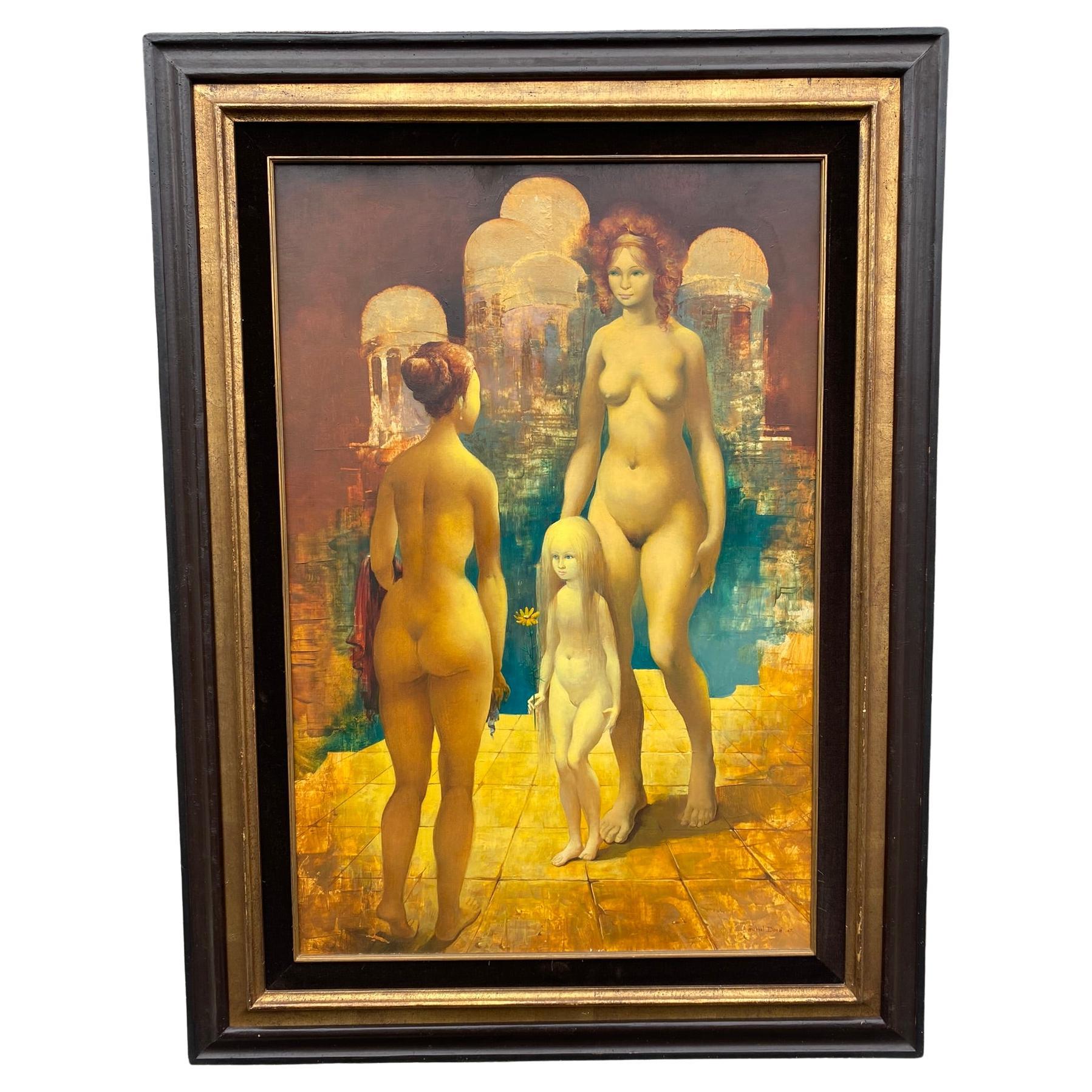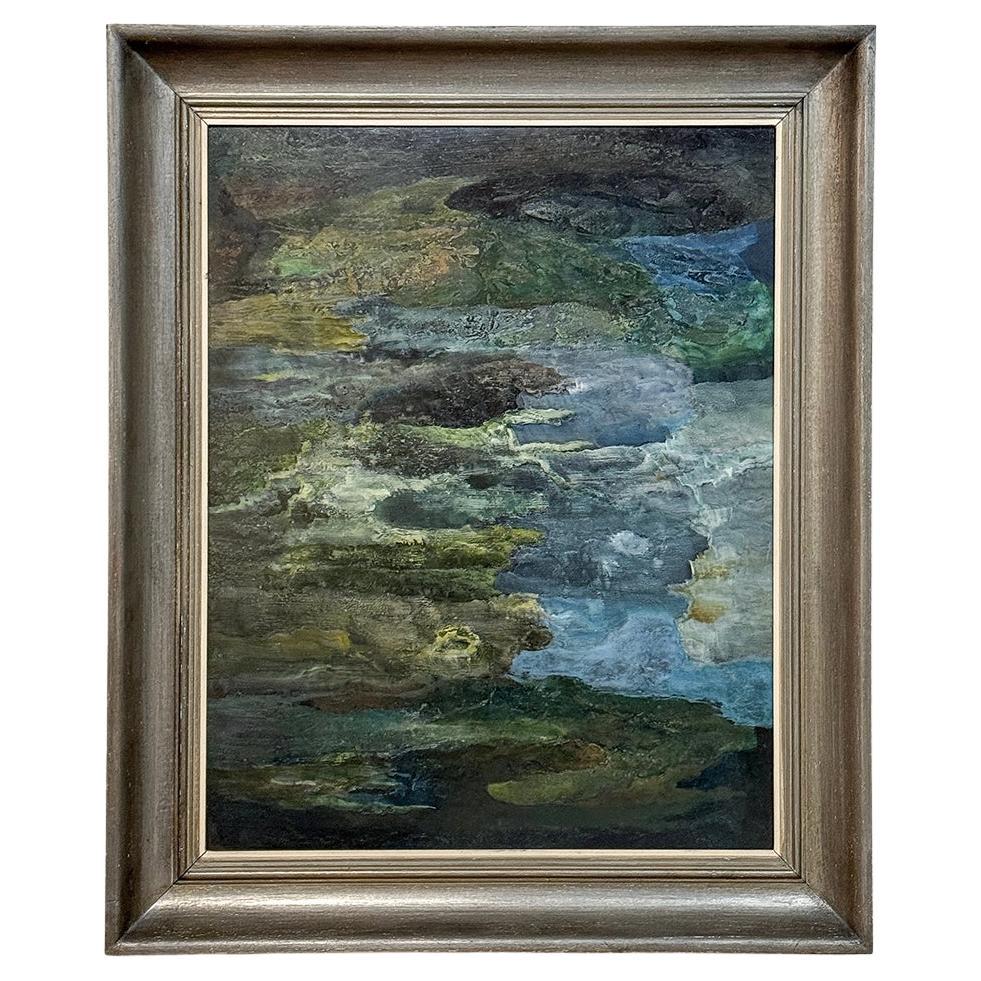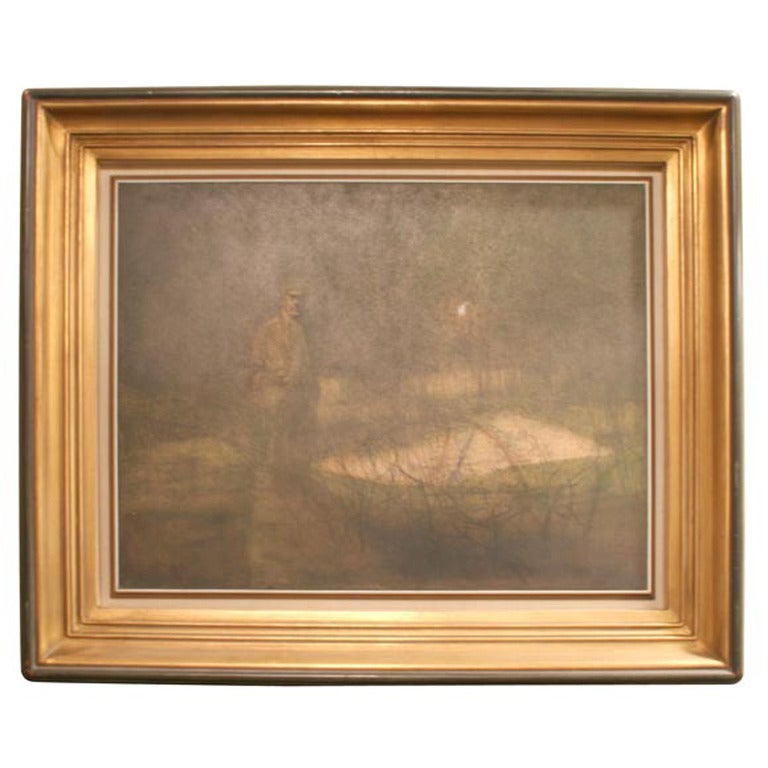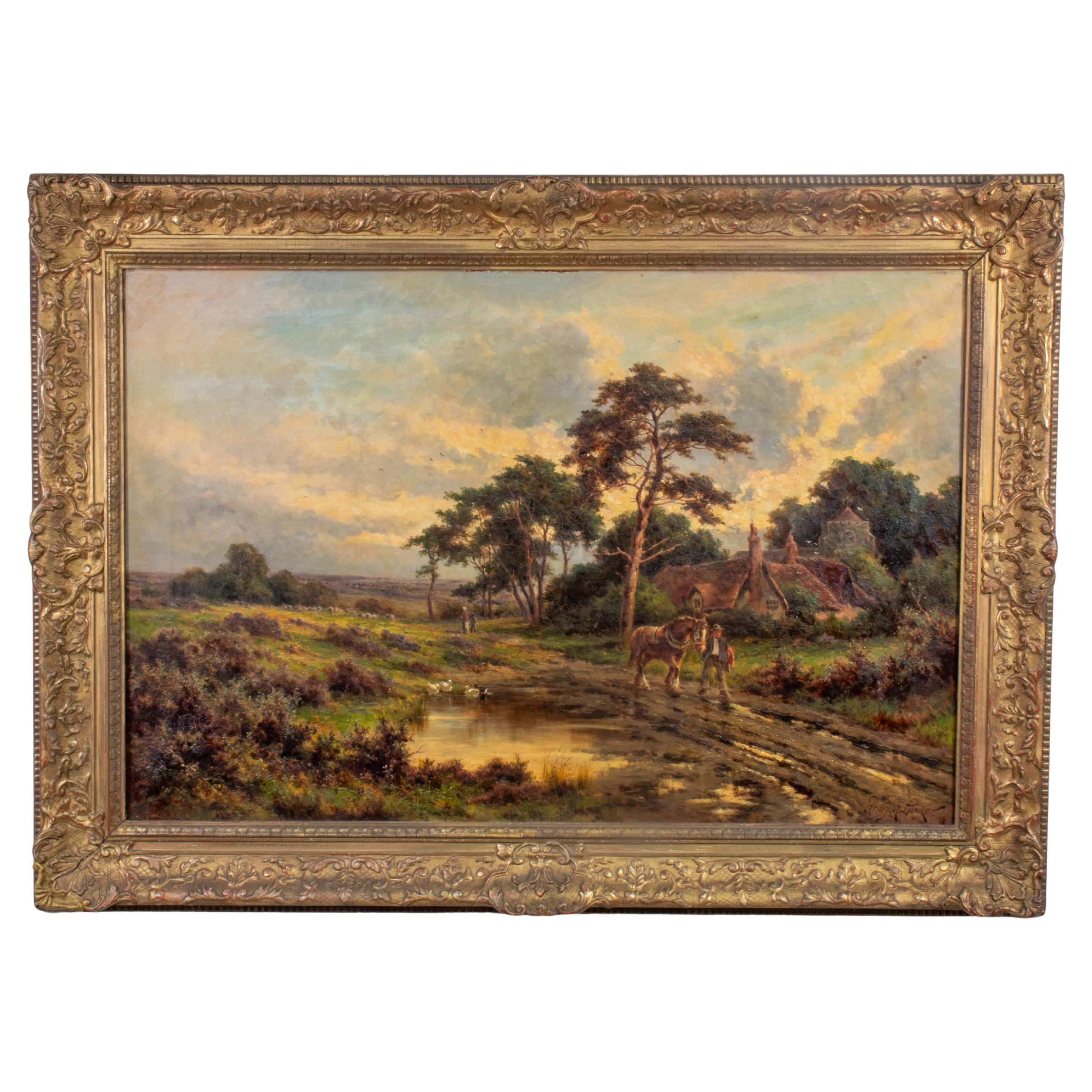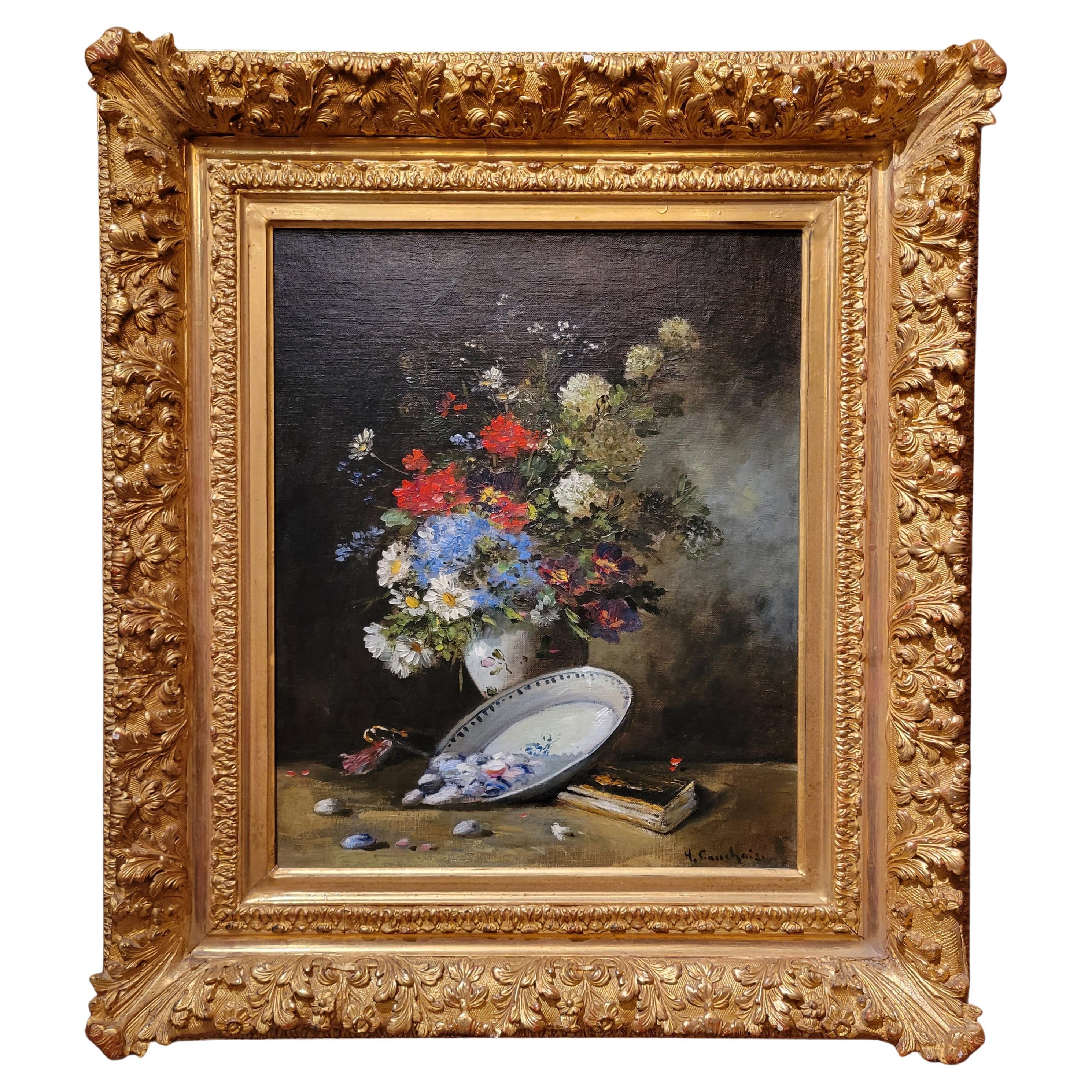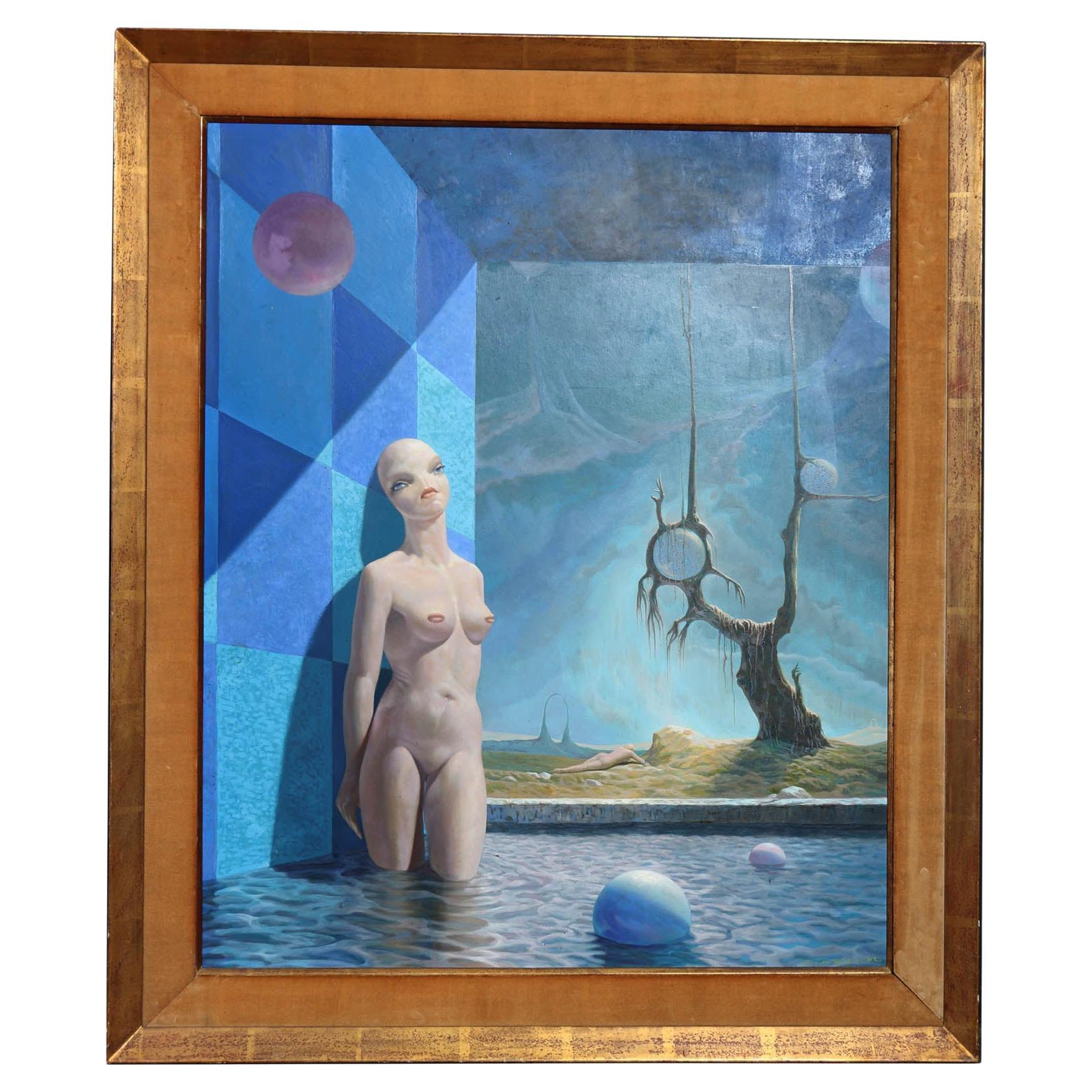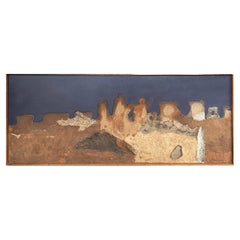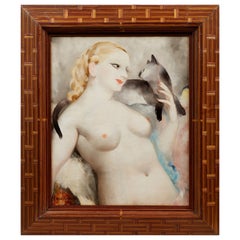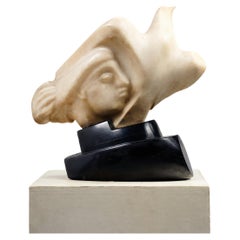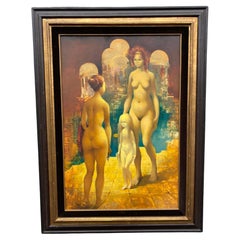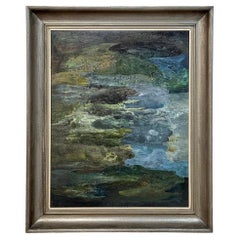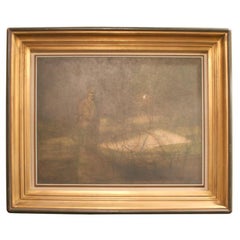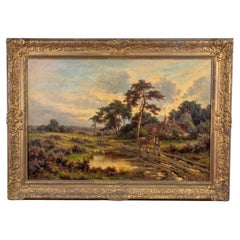Objekte ähnlich wie Eugène Berman (1899-1972) - Öl auf Leinwand "Paludia"
Möchten Sie mehr Bilder oder Videos?
Zusätzliche Bilder oder Videos von dem*der Anbieter*in anfordern
1 von 6
Eugène Berman (1899-1972) - Öl auf Leinwand "Paludia"
18.000 €Einschließlich MwSt.
Angaben zum Objekt
Eugène Berman - "Paludia" (1967-1968)
Type : Huile sur toile
Signature : Monogrammée en bas au centre, contresignée au dos
Date de création : 1967-Rome-1968
Dimensions : 67 cm x 54 cm
Encadrement : Rare cadre Troubadour en papier mâché, circa 1840
Expositions et provenance :
Étiquette d’exposition de la Galerie Lucie Weill au dos
Annotations de la Galerie Forni à Bologne
Bibliographie :
Galerie Lucie Weill, Les Néo-romantiques: Christian Bérard, Léonid et Eugène Berman, Pavel Tchelitchew, Paris, 1971.
"Paludia" est une huile sur toile réalisée par Eugène Berman entre 1967 et 1968 à Rome. L'œuvre, représentative de son style néo-romantique, est empreinte de mélancolie et de poésie, avec une touche onirique caractéristique de son approche théâtrale de la composition.
Son cadre troubadour en papier mâché, rare et datant de circa 1840, confère à l'œuvre une aura historique et une mise en valeur singulière, dans l'esprit des cabinets de curiosités qu'affectionnait l'artiste.
Biographie d'Eugène Berman (1899-1972) :
Né le 4 novembre 1899 à Saint-Pétersbourg, Eugène Berman est un peintre et décorateur de théâtre d’origine russe, naturalisé américain. Il est le frère de Léonide Berman.
Son éducation artistique débute en Europe occidentale, avec des formations en Allemagne, Suisse et France, où il suit les cours de Pavel Naumov et Sergey Gruzenberg entre 1914 et 1918. Après avoir quitté la Russie en 1918, il étudie à l'Académie Ranson à Paris, sous la direction de Maurice Denis et Édouard Vuillard.
Inspiré par Giorgio de Chirico et Picasso, il expose ses œuvres (portraits et paysages) aux Salons d’Automne et des Tuileries entre 1923 et 1927. Il promeut, aux côtés de son frère, une forme de peinture poétique et symboliste.
En 1935, il émigre aux États-Unis, où il travaille comme décorateur de théâtre tout en poursuivant son œuvre picturale. Il devient citoyen américain en 1937.
Il meurt le 14 décembre 1972, à Rome ou New York.
Cabinet de curiosités et collection personnelle :
Eugène Berman possédait une importante collection d’objets anciens, comprenant :
Céramiques, statuettes, sculptures, verrerie, textiles, tapis de diverses civilisations (précolombienne, africaine, de Nouvelle-Guinée, de Colombie-Britannique, égyptienne, copte, grecque, étrusque, romaine).
Mobilier italien et latino-américain du XVIe et XVIIe siècles.
Œuvres d’amis artistes, dont Mirko, Ernst, Cagli, Cremoni.
Sa collection fut installée dans un appartement romain, transformé en un véritable cabinet de curiosités, situé au dernier étage d’un palais proche de la Piazza del Popolo.
------------
Eugène Berman - "Paludia" (1967-1968)
Type: Oil on canvas
Signature: Monogrammed at the bottom center, countersigned on the back
Creation Date: 1967-Rome-1968
Dimensions: 67 cm x 54 cm
Frame: Rare Troubadour-style papier-mâché frame, circa 1840
Exhibitions and Provenance:
Exhibition label from Galerie Lucie Weill on the back
Annotations from Forni Gallery in Bologna
Bibliography:
Galerie Lucie Weill, The Neo-Romantics: Christian Bérard, Léonid and Eugène Berman, Pavel Tchelitchew, Paris, 1971.
"Paludia" is an oil on canvas created by Eugène Berman between 1967 and 1968 in Rome. Representative of his neo-romantic style, the piece exudes melancholy and poetic introspection, with a dreamlike quality reflecting his theatrical approach to composition.
The rare papier-mâché Troubadour frame, dating from circa 1840, enhances the historical aura of the work, aligning with the artist’s deep appreciation for curiosities and antiquities.
Biography of Eugène Berman (1899-1972):
Born on November 4, 1899, in Saint Petersburg, Eugène Berman was a Russian-born American painter and theater designer. He was the brother of Léonide Berman.
He received his early artistic education in Western Europe, training in Germany, Switzerland, and France, with studies under Pavel Naumov and Sergey Gruzenberg between 1914 and 1918. Leaving Russia in 1918, he studied at Académie Ranson in Paris, under the guidance of Maurice Denis and Édouard Vuillard.
Influenced by Giorgio de Chirico and Picasso, he exhibited his works (portraits and landscapes) at the Salons d’Automne and des Tuileries between 1923 and 1927. Alongside his brother, he championed a poetic and symbolic form of painting.
In 1935, he emigrated to the United States, working as a theater designer while continuing to produce allegorical works. He became an American citizen in 1937.
He passed away on December 14, 1972, in Rome or New York.
Cabinet of Curiosities and Personal Collection:
Eugène Berman owned a significant collection of antique artifacts, including:
Ceramics, statuettes, sculptures, glassware, textiles, and rugs from Pre-Columbian, African, New Guinea, British Columbia, Egyptian, Coptic, Greek, Etruscan, and Roman civilizations.
Italian and Latin American furniture from the 16th and 17th centuries.
Works from artist friends, including Mirko, Ernst, Cagli, and Cremoni.
His collection was housed in a Roman apartment, transformed into a true cabinet of curiosities, located on the top floor of a palace near Piazza del Popolo.
- Schöpfer*in:Eugene Berman (Künstler*in)
- Maße:Höhe: 67 cm (26,38 in)Breite: 5 cm (1,97 in)Tiefe: 54 cm (21,26 in)
- Stil:Amerikanische Klassik (Aus dem Zeitalter)
- Materialien und Methoden:
- Herkunftsort:
- Zeitalter:
- Herstellungsjahr:1967-1968
- Zustand:Abnutzung dem Alter und der Nutzung entsprechend.
- Anbieterstandort:NEUILLY-SUR-SEINE, FR
- Referenznummer:1stDibs: LU9892240411102
Anbieterinformationen
Noch keine Bewertungen
Anerkannte Anbieter*innen
Diese renommierten Anbieter*innen sind führend in der Branche und repräsentieren die höchste Klasse in Sachen Qualität und Design.
Gründungsjahr 1992
1stDibs-Anbieter*in seit 2024
- VersandAngebot wird abgerufen …Versand von: Saint-Ouen-sur-Seine, Frankreich
- Rückgabebedingungen
Einige Inhalte dieser Seite wurden automatisch übersetzt. Daher kann 1stDibs nicht die Richtigkeit der Übersetzungen garantieren. Englisch ist die Standardsprache dieser Website.
Mehr von diesem*dieser Anbieter*in
Alle anzeigenJean Piaubert - "Presence", 1965, Huile, sable et gravier sur panneau intitulé
Jean Piaubert - "Anwesenheit", 1965
Technik : Huile, sable et gravier sur panneau
Unterschrift : Signé en bas à droite
Abmessungen : H : 60 cm L : 150 cm
Provenienz :
Vente Me Lom...
Kategorie
Vintage, 1960er, Französisch, Art déco, Gemälde
Materialien
Sandstein
Georges Lepape – „La Femme, l'Enfant et la Famille“, Peinture et Miroir
Von Georges Lepape
Georges Lepape (1887-1971) - "Die Frau, das Kind und die Familie" (La Femme, l'Enfant et la Famille)
Technik : Gemischte Techniken auf Textil
Entstehungszeit: Um 1937
Abmessungen : ...
Kategorie
Vintage, 1930er, Französisch, Art déco, Gemälde
Materialien
Spiegel, Farbe
Miçao Kono - "Frau mit Katze" (1934) - Huile sur toile
Von Micao Kono
Miçao Kono - "Frau mit Katze" (1934)
Art : Huile sur toile
Signatur : Signée et datée 1934 en bas à gauche et au dos de l'œuvre
Umschlag : Exceptionnel cadre Art Déco en marqueteri...
Kategorie
Mitte des 20. Jahrhunderts, Japanisch, Art déco, Gemälde
Materialien
Farbe
Bildhauerei figurativ Maurice Lambert, Albâtre
Von Lambert & Fils
Maurice LAMBERT (1901-1964)
"Frau mit Vogel".
Alabasterdruck. Gestufter Sockel aus ebonisiertem Holz.
Monogramme ML.
Höhe: 42 cm; Breite: 50 cm; Tiefe: 20 cm
Nummeriert : 7339
Kategorie
Vintage, 1920er, Französisch, Art déco, Figurative Skulpturen
Materialien
Alabaster
Bildhauerei von Roger CHOMEAUX (1907-1999)
CHOMO, Roger CHOMEAUX (1907-1999)
Große Büste eines Mannes.
Skulptur aus Porenbeton mit blauer Patina und gestreifter Oberfläche. Blau lackiert, auf der Rückseite signiert.
Höhe: 61...
Kategorie
Vintage, 1980er, Französisch, Moderne der Mitte des Jahrhunderts, Figura...
Materialien
Beton
Émile Just Bachelet - Skulptur - "Tendresse" (um 1930)
Von Émile Just Bachelet
Émile Just Bachelet - Skulptur - "Tendresse" (um 1930)
Art : Skulptur in direkter Schneiderei auf Holz
Entstehungszeit: Um 1930
Abmessungen : H : 54 cm
Bibliographie :
Einzelheiten...
Kategorie
Mitte des 20. Jahrhunderts, Französisch, Art déco, Figurative Skulpturen
Materialien
Stein
Das könnte Ihnen auch gefallen
Michael Doré (1922) "Die venezianische Blondine" Öl auf Tafel signiert und datiert 1967
Von Yves Rhayé
Michael Doré (1922) "Le blond vénitien" Öl auf Tafel signiert und datiert 1967
Michael DORÉ ist ein 1922 in Belgien geborener Künstler.
Kategorie
Vintage, 1960er, Belgisch, Moderne der Mitte des Jahrhunderts, Gemälde
Materialien
Farbe
Gerahmtes Ölgemälde auf Tafel von Van Herberigs mit BOOK
Gerahmtes Ölgemälde auf Tafel von Van Herberigs mit BUCH ist ein interessantes Beispiel für das Werk des Künstlers. Herberig verwischte die Grenzen zwischen Postimpressionismus und ...
Kategorie
Vintage, 1970er, Belgisch, Ästhetizismus, Gemälde
Materialien
Holz, Sperrholz, Farbe
Öl auf Karton von Armand Merison
Von Armand Merison
Ein sehr bewegendes Gemälde von Armand Merison aus den 1980er Jahren.
Kategorie
20. Jahrhundert, Gemälde
Materialien
Holz
Ölgemälde auf Leinwand des späten 19. Jahrhunderts von Henry H. Parker „Homewards“
Von Henry H. Parker
Dieses ruhige Landschaftsgemälde aus dem viktorianischen Zeitalter mit dem Titel "Homewards" von Henry H. Parker zeigt eine üppige Wiedergabe der englischen Landschaft in der Morgend...
Kategorie
Antik, Spätes 19. Jahrhundert, Englisch, Viktorianisch, Gemälde
Materialien
Leinwand, Farbe
Antike Französisches Öl auf Leinwand
Von Eugene Henri Cauchois
Cauchois ist ein bekannter und gesuchter französischer Künstler dieser Zeit. Dies ist ein schönes Blumenstillleben.
Kategorie
Antik, Spätes 19. Jahrhundert, Französisch, Gemälde
Materialien
Leinwand
Ölgemälde auf Karton von Arthur Maria Rener, Mitte des Jahrhunderts
Arthur Maria Rener (1912-1991)
Tauchen Sie ein in die fesselnde Welt von Arthur Maria Rener, einem bedeutenden Künstler, dessen Werke über das Gewöhnliche hinausgehen und den Betrach...
Kategorie
Vintage, 1960er, Französisch, Moderne der Mitte des Jahrhunderts, Gemälde
Materialien
Vergoldetes Holz
